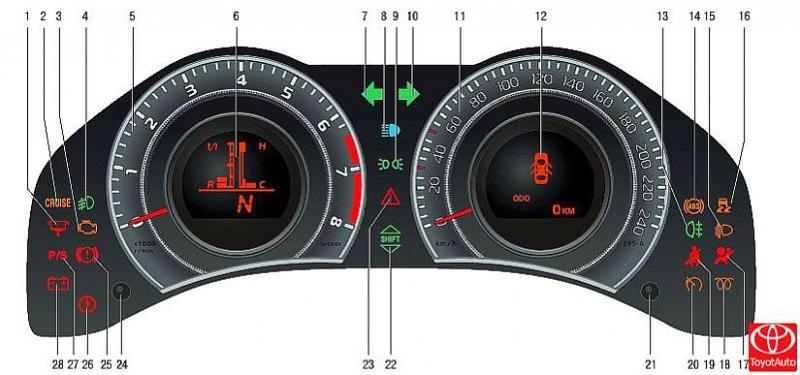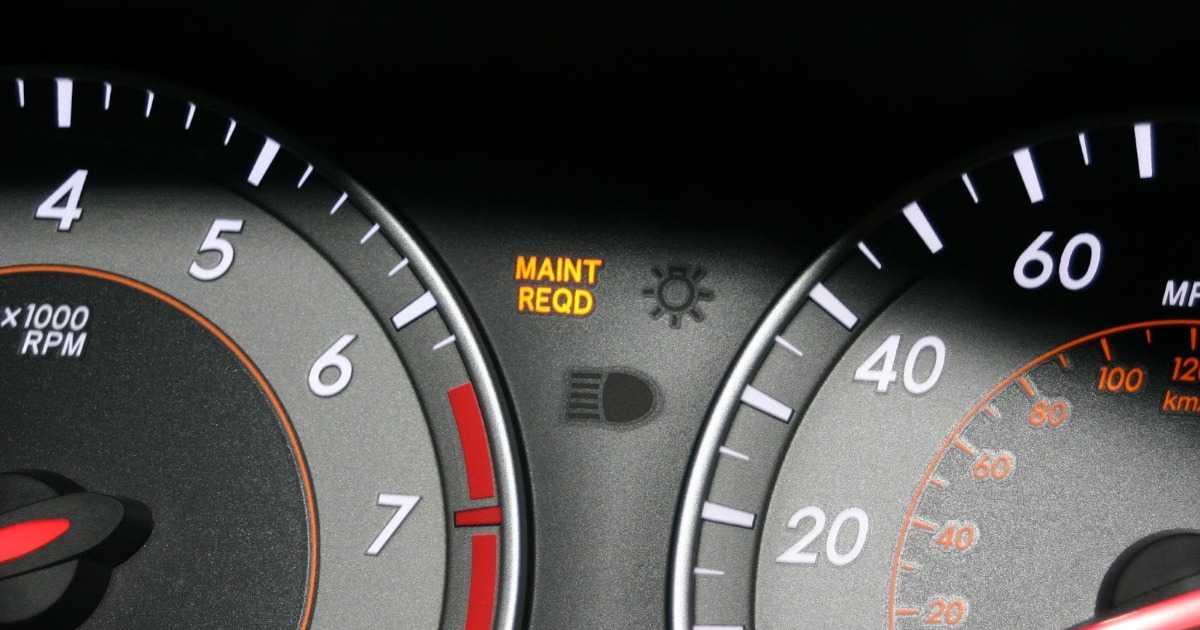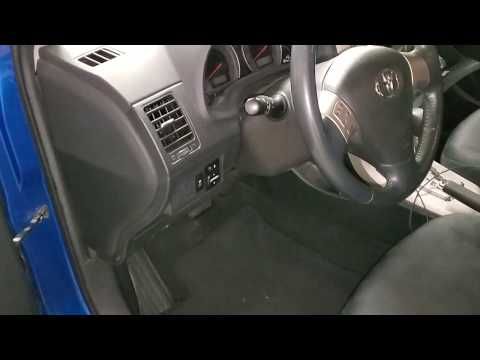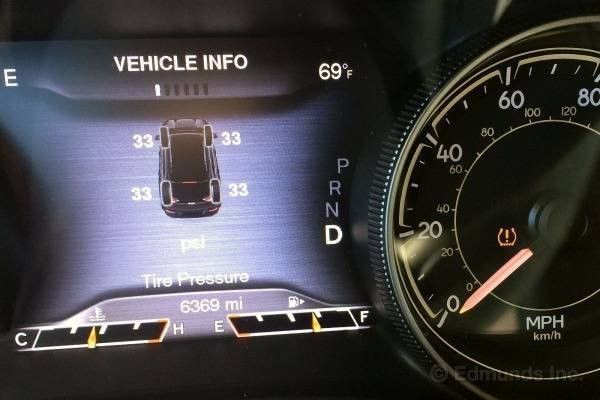The Toyota Corolla tire pressure warning system must be initialized / reset in the following circumstances:
When the tire pressure warning system is initialized / has been rest, the current tire inflation pressure is set as the benchmark pressure.
As you drive your vehicle, the tires heat up and the pressure inside increases. Ideally, tire pressures should be checked and corrected when the tires are cold. A cold tire is the same temperature as the surrounding outside (ambient) temperature. It takes approximately 3 hours for a tire to reach ambient temperature from the last time the vehicle was driven.
If it’s not possible to check / alter tire pressures when they are cold, it’s recommended to increase the pressure by an additional 4 psi (14 kPa) above the recommended cold pressure values for your Toyota Corolla.
Recommended tire pressures
The recommended tire pressures can be found on the placard located inside the driver’s door on the B-pillar. These tire pressures are based on Toyota factory fitted tires of a specific size and rating.
The following procedure explains how to reset the Toyota Corolla tire pressure monitoring system:
Toyota Corolla tire pressure reset button location
Toyota Corolla is equipped with Tire Pressure Monitoring System (TPMS) for the purpose of warning the driver when one or more of the tires are significantly under-inflated, creating a potentially unsafe driving condition. In this article we discuss the reasons for the amber colored TPMS warning light in Corolla, and how you can reset it.
In this article we discuss the reasons for the amber colored TPMS warning light in Corolla, and how you can reset it.
The TPMS warning light illuminates in Toyota Corolla when air pressure is low in one or more of the tires, battery has depleted in a pressure sensor, TPMS receiver module has malfunctioned, or a pressure sensor has been damaged.
When the amber colored TPMS warning light turns on in your Corolla, stop your vehicle when it is safe to do so and check tire pressure on all the wheels, including the spare wheel (if your vehicle has one). Driving on a significantly under-inflated tire causes the tire to overheat and can lead to tire failure.
Reinflate all the tires of your Corolla to the manufacturer specified air pressure, which is mentioned on the vehicle placard or tire inflation pressure label usually located on the B-pillar or the edge of the driver door. If you can’t find the label, check the size of your tire which is mentioned on the sidewall of the tire, and match it to the tire pressure information shown below. These are official cold tire pressure values for Corolla from Toyota.
If you can’t find the label, check the size of your tire which is mentioned on the sidewall of the tire, and match it to the tire pressure information shown below. These are official cold tire pressure values for Corolla from Toyota.
After you have inflated all the tires to the correct air pressure, the TPMS warning light should turn off automatically after driving for a few miles. Toyota Corolla uses the direct method for monitoring tire pressure, which means a pressure sensor actively records the internal pressure of the tire on each wheel. If the warning light doesn’t turn off you should perform a reset procedure from the instrument cluster settings.
If the warning light doesn’t turn off you should perform a reset procedure from the instrument cluster settings.
The tire pressure warning system must be initialized in the following circumstances:
When the tire pressure warning system is initialized, the current tire inflation pressure is set as the benchmark pressure.
 The tire pressure warning system will operate based on this pressure level.
The tire pressure warning system will operate based on this pressure level.WARNING: Do not initialize the tire pressure warning system without first adjusting the tire inflation pressure to the specified level. Otherwise, the tire pressure warning light may not come on even if the tire inflation pressure is low, or it may come on when the tire inflation pressure is actually normal.

If the low tire pressure light does not turn off automatically after reinflating the tires in your Corolla, increase the tire pressure by 5 psi on top of the factory recommended value, and drive your vehicle for at least 10 miles (16 km). After the TPMS warning light turns off, and the vehicle has been parked for a few hours, reduce the tire pressure to the factory recommended value.
Note: When the light comes on after blinking for 1 minute, there is a malfunction in the tire pressure warning system.
Cold weather is one of the most common cause for low tire pressure warning light in Toyota Corolla. When analyzing WheelsJoint’s statistical data, it has been observed that there is sharp rise in the number of searches for TPMS warning light causes at the start of every winter season, about three times higher as compared to mid summer season.
The air, like most other substances, expands when heated and contracts when cooled. So when the weather gets colder, the tire pressure decreases, which could trigger TPMS warning light in Corolla. The tire pressure will vary with temperature by about 1 psi (7 kPa) for every 12°F (6.5°C).
Tire pressure vs temperature: This chart shows how tire pressure of 35 psi at temperature of 35°C (95°F) decreases by roughly 1.6 psi with every 10°C (18°F) drop in temperature.Tire pressure in Corolla should always be set based on cold inflation tire pressure. This is defined as the tire pressure after the vehicle has not been driven for at least three hours, or driven less than 1 mile (1.6 km) after a three-hour period.
The tires on your Corolla can get around 50 degrees hotter than the outside temperature when you’re driving, which increases the tire pressure by about 4 psi – this is normal and there should be no adjustment for this increased pressure.
Yes, altitude can change tire pressure values, but it is negligible and not a cause for concern. If you drive your Corolla from sea level to Mount Evans Scenic Byway in Colorado which is the highest paved road in North America at the altitude of 14,130 feet (4,307 m), the tire pressure should theoretically increase by approximately 6 psi. But, the decrease in ambient temperature at higher elevation contracts the air in tires and compensates for any altitude pressure changes.
The driving characteristics of Corolla change even if the air pressure is 5 psi less than manufacturer’s recommended value: the braking distance can be longer, cornering worse, and at particularly high speeds there is even a risk that the tire will burst. Low tire pressure also increases tire wear, and the higher rolling resistance of the tire means higher fuel consumption. So it is recommended to reinflate the tires to the correct pressure as soon as possible.
Each tire pressure sensor in Corolla is powered by a built-in lithium-ion battery. When the battery is depleted, the sensor stops transmitting tire pressure information to the receiver module. When this happens, the TPMS warning light will flash every time the engine is started, and will remain illuminated until you turn off the vehicle.
The tire pressure sensor batteries usually last anywhere from 5 to 10 years in Corolla. When the battery is depleted, you must replace the sensor itself, as the battery is sealed into the sensor unit and is non-replaceable.
The most reliable method for detecting a faulty tire pressure sensor or a sensor with dead battery is by testing each sensor with a scan tool. For example, MaxiTPMS TS408 is commonly used for diagnosing and programming tire pressure sensors. A sensor that is not detectable by the scanner is most likely defective and should be replaced with a new one.
If you don’t want to spend over a hundred bucks on a scanner, then head over to any reputable tire shop and perform a TPMS diagnostic scan of your Corolla. Some shops like Discount Tire and Pep Boys offer free of charge TPMS diagnostic services.
If a pressure sensor stopped responding after you installed new tires on your Corolla, it is possible the sensor got damaged during tire installation. These sensors are quite sensitive, and can be easily damaged if utmost care is not taken while changing tires.
Your vehicle is equipped with a tire pressure warning system that uses tire pressure warning valves and transmitters to detect low tire inflation pressure before serious problems arise.
If the tire pressure drops below a predetermined level, the driver is warned by a warning light.
 Also, make sure the tires are cold before carrying out initialization or tire inflation pressure adjustment.
Also, make sure the tires are cold before carrying out initialization or tire inflation pressure adjustment.Initialization can be completed in a few minutes. However, in the following cases, the settings have not been recorded and the system will not operate properly. If repeated attempts to record tire inflation pressure settings are unsuccessful, have the vehicle inspected by your Toyota dealer.

The tire pressure warning system does not replace routine tire inflation pressure checks. Make sure to check tire inflation pressure as part of your routine of daily vehicle checks.
In the following cases, the tire pressure warning system may not operate properly.

Performance may be affected in the following situations.
When the vehicle is parked, the time taken for the warning to start or go off could be extended.
When tire inflation pressure declines rapidly for example when a tire has burst, the warning may not function.
The warning of the tire pressure warning system will change in accordance with driving conditions. For this reason, the system may give a warning even if the tire pressure does not reach a low enough level, or if the pressure is higher than the pressure that was adjusted to when the system was initialized.
For this reason, the system may give a warning even if the tire pressure does not reach a low enough level, or if the pressure is higher than the pressure that was adjusted to when the system was initialized.
When replacing tires or wheels, tire pressure warning valves and transmitters must also be installed. When new tire pressure warning valves and transmitters are installed, new ID codes must be registered in the tire pressure warning computer and the tire pressure warning system must be initialized. Have tire pressure warning valves and transmitter ID codes registered by your Toyota dealer.
If the ID code of the tire pressure warning valve and transmitter is not registered, the tire pressure warning system will not work properly. After driving for about 20 minutes, the tire pressure warning light blinks for 1 minute and stays on to indicate a system malfunction.

When a tire is repaired with liquid sealants, the tire pressure warning valve and transmitter may not operate properly. If a liquid sealant is used, contact your Toyota dealer or other qualified service shop as soon as possible. Make sure to replace the tire pressure warning valve and transmitter when replacing the tire.
The tire pressure warning valve and transmitter is equipped with a unique ID code. When replacing a tire pressure warning valve and transmitter, it is necessary to register the ID code.
Your vehicle is equipped with tire pressure warning system with the function to have ID codes registered for a second wheel set, for example a winter set, by Toyota dealer. After registration of a second wheel set, either of these two wheel sets can be selected for usage with the tire pressure warning system.
After registration of a second wheel set, either of these two wheel sets can be selected for usage with the tire pressure warning system.

If the low tire pressure warning light won’t turn off due to a glitch in the tire pressure monitoring system, it may be possible to reset the TPMS system by resetting all on-board computers in your Corolla. This method should only be considered as a last resort, when all else fails.
Disconnect both negative and positive terminals of the battery.You can reboot all the on-board computers by disconnecting the main 12 volt battery for a few minutes. Remove the cable from the negative terminal of the battery first, then from the positive terminal. With the battery disconnected, press the horn button a few times and turn on the headlights to drain out all the residual electricity from the system. After about 15 minutes, reconnect the battery in reverse order: positive cable first, then negative cable.
If the TPMS warning light turns on frequently in your Corolla, and the tire pressure is also decreasing after you have reinflated the tires, there may be an air leak. One or more of the tires may have been punctured by an external object, or the air may be leaking from a defective value stem.
One or more of the tires may have been punctured by an external object, or the air may be leaking from a defective value stem.
No, the TPMS system is federally mandated, and cannot be disabled in Toyota Corolla. All vehicles must have a working tire pressure monitoring system to be legally compliant.
Since Toyota Corolla is equipped with on-board diagnostics (OBD), a fault diagnosis can provide initial indications of where the malfunction is located. But when it comes to TPMS, a basic code reader will not suffice. You will need an advanced scanner to monitor TPMS data or read TPMS codes.
BlueDriver is a Bluetooth based diagnostic device which you can connect to the OBDII port in your vehicle and use your mobile phone for diagnosis. You will need to download the “BlueDriver OBD2 Scan Tool” app from the App Store on your iPhone, or from Google Play Store if you have an Android phone.
BlueDriver is a commonly used scanner by DIYers that can read TPMS codes for most vehicles and isn’t too expensive – costs about a hundred bucks. You can also clear the TPMS fault codes with this device which will turn off the warning light, but the light may come back on if the on-board diagnostic system detects a fault again.
You are the proud owner of a recent car, the benefits of tactile devices, integrated technology should bring you the ease and comfort of using your Toyota Corolla, however, this is to say that the technology is talking about electronic, and as we all unfortunately know, that sometimes there are problems to solve. Today we will focus on the tire pressure sensor and specifically the tire pressure sensor. How to reset the Toyota Corolla tire pressure sensor so that this indicator is no longer displayed on the dashboard. To do this, we will divide our article into two parts: first we will discuss the typical case of a tire pressure indicator light and the subsequent process, and then the case where the tire pressure indicator remains on even if the tires are inflated. So, how to reset this tire sensor on a Toyota Corolla.
So, how to reset this tire sensor on a Toyota Corolla.
First, we will look at the general approach to reset the tire sensor on a Toyota Corolla which, if it lights up, here are the basic steps:
 Toyota Corolla. The indicator should disappear or turn off after a few seconds. . If this is not the case, we recommend that you review the following sections.
Toyota Corolla. The indicator should disappear or turn off after a few seconds. . If this is not the case, we recommend that you review the following sections.  You can now turn off the ignition and restart your Toyota Corolla to see if the tire pressure light has gone out.
You can now turn off the ignition and restart your Toyota Corolla to see if the tire pressure light has gone out. For more Toyota Corolla tips, take a look at the Toyota Corolla category.
This system is designed to alert the driver of low tire pressure. If, while driving, a pressure drop in one of the wheels is detected, the corresponding indicator lights up on the instrument cluster, indicating the need for immediate pressure adjustment.
If, while driving, a pressure drop in one of the wheels is detected, the corresponding indicator lights up on the instrument cluster, indicating the need for immediate pressure adjustment.
1. How it works.
The tire pressure monitoring system (TPMS - Tire Pressure Monitoring System), used on Toyotas, refers to "indirect" action schemes and functions as part of ABS, which is able to perceive a constant difference in wheel speed (a flat tire has less rolling radius and therefore rotates slightly faster).
But such a TPMS cannot simply compare the speed of one individual wheel with the rest, because the car does not move in an absolute straight line very often, in any corners, the outer wheels will always travel more than the inner ones, and the front wheels more than the rear ones. Therefore, a conventional control system adds the speeds of each two diagonal wheels, calculates the difference between these sums, and divides it by the average speed of all four wheels. If the obtained ratio differs from the set one, then the system diagnoses the change in pressure, but it cannot identify a specific tire.
If the obtained ratio differs from the set one, then the system diagnoses the change in pressure, but it cannot identify a specific tire.
The disadvantages of this scheme are:
- impossibility to determine a sharp drop in pressure;
- the inability to determine simultaneously the pressure drop even in two wheels located on the same side or the same axle, not to mention all four wheels;
- the dependence of the system performance on the degree of wheel slip, the condition of the rubber and the vehicle load;
- actuation in case of pressure drop not less than 25-30%;
- the need for long-term calibration (pre-setting).
In this regard, Toyota used in parallel a second method of pressure control using ABS. The fact is that the tire and the rim actually represent an oscillatory circuit, the characteristics of which directly depend on the elasticity of the tire, and hence the pressure in it (meaning the circular vibrations of the tire in the direction of rotation). It turned out to be possible to isolate the frequency of these oscillations from the signal of the wheel speed sensor, and to judge the pressure drop by its change.
However, TPMS has a noticeable inertia - in order to detect a flat tire, you need to drive a considerable distance (sometimes up to 20-30 km), you will have to go a long way even after normalizing the pressure so that the indicator goes out.
2. Development.
This system was introduced by Toyota in the second half of the 1990s. As you can see, it was used mainly on models of the Corolla family and large rear-wheel drive cars, ranging from class E and above.
But it seems that the Japanese cooled off quite quickly to this scheme, so today they have abandoned its use on most models, including the Corolla 120 of the later years of production.
| Model | Series | Release |
| Corolla | #E10# | 04. 1997-04.1998 1997-04.1998 |
| Corolla/Sprinter | #E11# | 04.1997-04.1998 |
| Corolla | AE100, AE104, CE101 | 04.1998-08.2000 |
| Corolla/Sprinter | AE110, AE114, CE11#, EE111 | 04.1998-08.2000 |
| Sprinter Carib | AE11# | 04.1998-07.2002 |
| Corolla Levin/Sprinter Trueno | AE11# | 04.1998-08.2000 |
| Corolla Spacio | AE11# | 04.1998-05.2001 |
| Corolla / Corolla Fielder | CE121, NZE12#, ZZE122, ZZZE124 | 08.2000- |
| Corolla Runx/Corolla Allex | NZE12#, ZZE122, ZZE124 | 01.2001- |
| Corolla Spacio | NZE121,ZZE12# | 05. 2001- 2001- |
| Mark II | JZX101 | 09.1996-08.1998 |
| Mark II | JZX100, JZX101 | 08.1998-10.2000 |
| Mark II / Mark II Blit | JZX110 | 10.2000- |
| Chaser / Cresta | JZX101 | 09.1996-08.1998 |
| Chaser / Cresta | JZX100, JZX101 | 08.1998-06.2001 |
| Crown / Crown Majesta | JKS175, JZS171, JZS175, JZS177, UZS171, UZS175 | 09.1999-2005 |
| Century | GZG50 | 04.1997- |
| Celsior | UCF3# | 08.2000- |
3. Indicator.
There are at least two options for indicators on the instrument cluster - ISO K11 and K10. The most famous of them, of course, is the first one - the "horseshoe with arrows". By the way, in the Western world with these indicators there is a similar problem - "what kind of light bulb is this?" - according to surveys, most of the drivers there do not understand their meaning.
The most famous of them, of course, is the first one - the "horseshoe with arrows". By the way, in the Western world with these indicators there is a similar problem - "what kind of light bulb is this?" - according to surveys, most of the drivers there do not understand their meaning.
A good indicator should come on when the ignition is turned on and go out after 3 seconds. If the system has detected a drop in tire pressure, then in order for the indicator to go out, after normalizing the pressure, it is necessary to drive a certain distance at a speed of at least 30 km / h. The indicator is powered directly from the output of the ABS control unit.
The principles of the system allow for the possibility of its incorrect operation (the indicator does not light up at low tire pressure or, conversely, it lights up at normal) under the following conditions:
- tires of non-recommended size are used,
- tires of different sizes or models are installed on different wheels,
- wheels have different grip,
- used spare wheel - "dokatka",
- used wheels with snow chains,
- tire pressure significantly exceeds the nominal,
- the pressure in the tire has dropped sharply due to a puncture,
- the system has not been pre-configured,
- the car is moving on a rough or icy road,
- the vehicle is moving at a speed below 30 km/h,
- for short trips (up to 5 minutes).
If the indicator stays on at normal pressure and in the absence of these conditions, this may indicate a malfunction of the TPMS itself.
4. Presetting.
Adjustment must be done after any wheel and tire (disc) replacement work has been performed, otherwise the system will not function properly. The adjustment procedure is shown below (preliminary pressure in all four wheels must be correctly adjusted).
Type 1 - models without setting button and with DLC1 connector (early version)
1) Turn on the ignition.
2) Connect the terminals "TS" and "E1" of the diagnostic connector DLC1 under the hood.
3) After 30 seconds, depress and hold the brake pedal until the system indicator flashes 3 times at 2 second intervals.
Type 2 - Pushbutton Models with DLC1 Connector (Transition)
Note. The installation buttons have several design options - with a pictogram, with an inscription or nothing at all, but differ in their characteristic shape and location - at the bottom of the instrument panel on the driver's side.
1) Turn on the ignition (the car must be stationary).
2) Connect the terminals "TS" and "E1" of the diagnostic connector DLC1 under the hood.
3) Press and hold the setting button until the system indicator blinks 3 times.
4) After that, in order for the system to save the correct settings, it is necessary to drive a certain distance.
Type 3 - models with setting button and without DLC1 connector (late version)
1) Turn on the ignition (the car must be stationary).
2) Press and hold the setting button until the system indicator blinks 3 times.
3) After that, in order for the system to save the correct settings, it is necessary to drive a certain distance.